Guest Post by Dr Monica Seeley
Information overload and its sibling email overload continue to plague most business users. Indeed although the latest figures for sick leave have been falling, the incidences of stress related illness have risen.

Information overload and email overload are major contributors to stress related illness. Our brains just cannot cope with the volume of information being pushed at us, through email and now social technologies. It has been suggested that we are now bombarded through these channels with the equivalent of 174 newspapers per day!
In the case of email, a major problem is actually trying to understand what the sender is really trying to say. For example, they reply with a simple word like ‘Thanks’. What do they really mean? Thanks for your help in a kindly way? ‘Thanks’ as a sarcastic remark for ‘dam you, what have you dropped me in’?
Conversely consider the long email which you read and re-read several times and still have no idea what is either being said or asked of you. There then ensues a second if not several rounds of useless email exchanges whilst each tries to comprehend the other.
Then there are the other elements of the email, such as the greeting and sign off. The pace of life and ferocity of the information tsunami is such that within five seconds, yes five seconds, the recipient of your email has formed an impression of you through your email and decided what type of business relationship they want to develop with you.
Your goal should be to convey the right image and message right first time. This helps reduce the volume of email traffic and hence information overload.
Your greeting and sign off should reflect just how you want the recipient to perceive you. The content (and subject-line) meanwhile should make it crystal clear what you are saying/asking. Just remember your email is one of on average 60 which the recipient receives each day. So it needs to stand out and enable the recipient to see the wood for the trees. Otherwise you are simply stoking up the information overload fire.
Dr Monica Seeley is a leading expert on how effective use of email can help you save time and improve productivity. She is author of ‘Brilliant Email’ and co-author of ‘Managing in the Email Office’. See www.mesmo.co.uk for more information.

